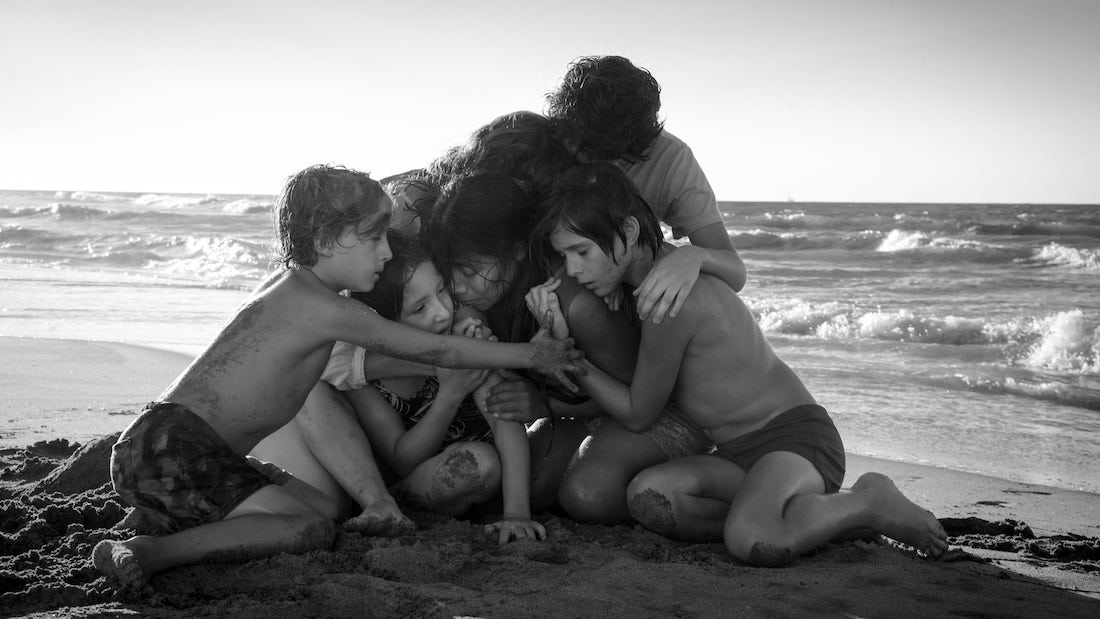ROMA (2018)
A year in the life of a middle-class family's maid in Mexico City in the early 1970s.

A year in the life of a middle-class family's maid in Mexico City in the early 1970s.


There’s an argument, typified by Michael Bay’s recent piece of Netflix bilge 6 Underground (2019), that in the age of VOD you have to grab audiences from the opening minute… because, if you don’t, they’ll stop streaming and start something else. This could mean an opening done in media res, it could mean packing 60 cuts into the first 60 seconds, or it could simply mean dramatic music. Roma, which until The Irishman (2019) was Netflix’s most prestigious film production, opens with a shot of black-and-white paving stones with no music and Spanish language titles. It holds that shot for longer than a minute. We’re enveloped by the echoing sounds of a neighbourhood in the early morning quiet and, as soapy water washes over the slabs, we see reflected in its surface the distant shape of a passenger jet skating overhead.
A dramatic opening it isn’t… but it’s an engrossing one. From here we are introduced to the life of Cleo (Yalitza Aparicio), a live-in domestic servant to an upper-middle-class family in Mexico City circa 1970. Cleo cleans the house, helps prepare and serve food, does the laundry, and helps to care for the family’s four young children. But her menial life gets thrown into disarray by two absentee fathers: one the patriarch of the family; another the source of Cleo’s unexpected pregnancy. Cuarón’s script is an everyday feminist tale of two women left to fill that void and hold everything together. There’s nothing showy about it, but the story will break your heart and cradle the pieces together as best as possible.
There are several things that can’t go unmentioned when discussing Roma—the first of which is the startling performances by Aparicio as Cleo, and Marina de Tavira as the matriarch Sofía. Aparicio gives Cleo wide-eyed innocence but also quiet grace. She’s an observer; inside the walls, but in the background, even of her own life. Cleo’s also honest, kind, and loving. Sofía is loving, too, but radiates desperate energy. She knows the family unit is crumbling, cut adrift from the stability of their patriarch and his income. Both give entirely convincing performances.
The second thing to mention is the sound design. The film’s sound was produced in Dolby Atmos and is rich with texture even when played through more economical speakers. The sound of a marching band approaching, the constant jets overhead, the children scampering and bickering…. the film has no score and, as a result, maximum attention was paid to the sound design and how it punctuates scenes. It is unlikely Roma will be the first film people will test out when buying a Dolby Atmos system, but it should be.
The third thing that cannot go unmentioned is the film’s monumental cinematography. Lensed by Cuarón himself after Emmanuel Lubezki was forced to leave the project, it is the film’s big creative decision. Filmed in black-and-white on Arri Alexa 65 digital cameras, the images captured aren’t post-processed with artificial grain and halation to imitate celluloid, but utilised high-tech methods such as reshooting locations at multiple exposure levels and combining them in postproduction to allow for wide frames with effectively 100% depth of field and lush detail in both shadows and highlights. It’s a new form of black-and-white cinematography (the complexities of which will likely go unnoticed by most) and a typifying example of Roma’s understated virtuosity.
A similarly understated brilliance has been performed in the cutting room, where editors Adam Gough and Cuarón (himself, again) keep the locked-off shots running for extended amounts of time, but without the fluid movement and “how did they do that?” moments normally associated with long shots. Instead, the long shots are used to remove artifice and increase naturalism, never breaking our concentration or our connection with the characters. Every creative decision, even the black-and-white, has been made to reduce the mental distance between us and the world we are watching.
When Roma just missed out on ‘Best Picture’ at the 91st Academy Awards, there was much discussion about the validity of streaming services and their connection to cinema, a debate that has only intensified this year (albeit in a slightly tongue-in-cheek way) after Martin Scorsese’s unfortunate comments. That’s why it’s great that Criterion chose to honour Roma with entry into their esteemed Collection barely a year since it’s release.
For the vast majority of a film’s lifetime, it exists as a home entertainment product, to the point that the venue of its initial release is immaterial. Divorced from the debate that surrounded it, Roma is undoubtedly a work of cinematic brilliance. But also, more than that, it’s an essential piece of cinema and perhaps the most recent example of invisible technological advancements truly in the service of the narrative. In the years to come, Roma will change the way films are made, not just the way they are exhibited.
writer & director: Alfonso Cuarón.
starring: Yalitza Aparicio, Marina de Tavira, Fernando Grediaga, Jorge Antonio Guerrero, Marco Graf, Daniela Demesa, Diego Cortina Autrey & Carlos Peralta.
